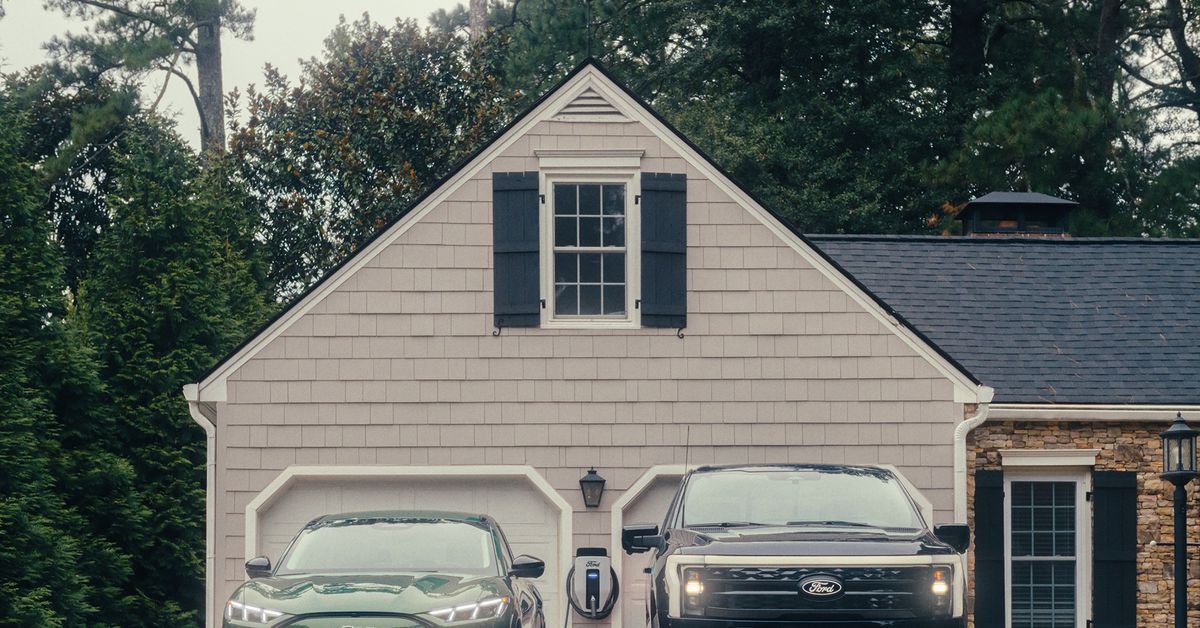For customers still unsure whether they’re ready to make the switch to an all-electric vehicle, Ford is sweetening the pot.
Today, the company launched a new initiative called the “Ford Power Promise,” in which it will provide a suite of benefits to customers who buy or lease a new EV. And chief among them is a complimentary home charger for all new customers, as well as the costs of standard installation.
The charger that’s being offered is the company’s Ford Charge Station Pro, a $1,310 Level 2 charger that comes with a standard CCS1 connector. Ford declined to put a monetary value on the installation but said it would cover costs up to 60 amps of power and 80 feet of wire run. Customers who need to upgrade their home electrical panel before the installation, however, will need to cover those costs themselves.



So since the majority of people will probably need the panel upgrade this is an empty offer for those that won’t be willing to spend $2k+ for the upgrade.
The only way I was able to get a charger installed was from my utility company’s rebate if I used their rate22 for the charger. So they paid to install the new meter and charger but I had to buy the charger. Since it has its own meter it doesn’t affect my home’s panel limit. I went with OpenEVSE for their ease of repairability and upgrades. I can swap any part out in a matter of minutes.
Came here to mention that they better be hooking me up with a panel upgrade too, which I know they won’t.
What panel do y’all mean - the circuit breaker panel?
Educated guess here, but yes. Your panel might only be designed to handle 200A and a bulk of that is typically used by your home already, primarily your major appliances and heating/cooling.
What are you talking about? 200A is a HUGE panel as it is. You’re going to have a hard time getting bigger than that on a residential connection. If you go balls to the wall with the big stuff in your house, you’d be looking at about 30 amps for AC, 50 for stove and oven (by the way, that’s all burners and oven running at the same time. Happy Thanksgiving?), 30 for a clothes dryer, and you still have 90 amps at 240 volts remaining.
Oh, and realistically that’s two 90-amp sets of 120 volts. And really, most people charge their car at night, when demand and rates are lower. Maybe your AC is going to run occasionally, but you’re probably not making that Thanksgiving feast while laundry is going
You forgot the furnace and water heater. If those are electric, it can easily max out a 200 amp panel.
Also, the fact that you’ll never use the full 50 amps on the range isn’t really important. There are calculations on how much you can overbook your panel. Once you hit that limit, electricians and code won’t allow it.
Admittedly I use gas for both those things, so yes, I did forget about them. The point largely remains: it’s highly unlikely that you’ll have all loads going at full blast, and for that reason the load calculation is far more complex than simply adding up the breakers. It also understands that circuits are generally only partially used, and that the worst case scenario is a nuisance, not a hazard.
Add to this if your home was built in the ancient times like before the 90s your panel usually only supported up to 100 amps. My house built in 1956 only has a 100 amp panel and if you have a electric oven those take 40 of those 100 amps which doesn’t leave much for a car charger. So when I remodeled my garage I removed the electric oven from our kitchen and installed gas just so I could avoid upgrading my panel and could dedicate 40 amps to the garage.
I know gas bad but my oven connects to my Home Assistant and it turns on and locks the kitchen ventilation to on while in use. Also have many air quality sensors.
Sure hope that you’re saving money using gas for your oven instead of electricity otherwise there’s no logic to how you did things…
Well $2000+ for the panel upgrade and $450 for the oven and black pipe to plumb the gas. So yes cheaper, also gas is cheaper than electric per BTU in my area. I may do my own panel upgrade in the coming years when I install solar.
Gas is also a big benefit when your power goes out. We still had hot water and a fireplace when we lost power for 5 days a few years ago after a big ice storm. Our stove is electric but we were able to use the BBQ to cook during that outage.
Lol, 100amp here.
Interesting. So maybe you need more power from the street (bigger cable trenched) and a “bigger” circuit breaker panel.
Further complicating matters for many Americans are HOAs, especially those with communal parking separated from the homes. Not only would I have to upgrade my panel, I’d have to pay to install a feed to my parking spaces. Thankfully for my region the law gives me the right to install this even if the HOA doesn’t cooperate, but laws vary and some people will have a very uphill battle.
“up to” 60 amps per the original snippet means you could do less if a load calculation needs it. Really, damn near any panel installed in the last several decades can take an additional 240V 20A circuit, which is still a lot of juice if you math out the kind of use you can get over a year.